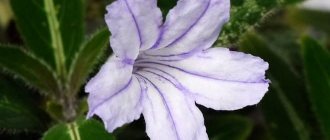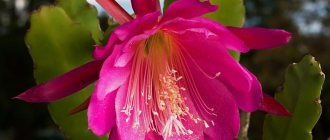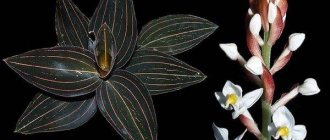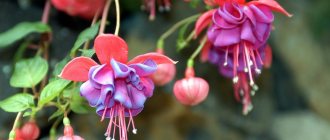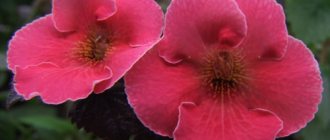Recently, many lovers of house plants can find an unusual and beautiful shrub, which is called indoor hop or crayfish neck due to the fact that the unusual inflorescences of the plant resemble a shrimp or long hop cones. The botanical name of this plant is beloperone. The entire genus of these plants, growing in different conditions, has about 60 varieties and subspecies. Flower growers most often encounter a striking specimen - Beloperone guttata, which will be discussed in this article. Simple home care for beloperone has made this beautiful plant popular, which blooms almost all year round.
An evergreen plant belonging to the Acanthaceae family, it grows as a shrub up to one meter in height. With pubescent stems and unusual inflorescences: orange-red, yellow-pink or brown, downward-sloping bracts that cover long white flower petals. Due to its long flowering period, crayfish can be an excellent decoration for a home or office throughout the year. The place of origin is Mexico, so the shrub loves clean air and sun, but not scorching direct rays. To properly care for indoor beloperone plants, you should know some nuances.
Lighting
The tropical beauty is sun-loving; in low light, its bracts may lose their brightness and become pale. It grows well and feels comfortable in bright but diffused light on the south or southeast side. Beloperone tolerates direct sunlight well only in the morning and evening. In summer, especially during the zenith of the sun, the plant should be provided with light shading.
Due to poor natural light in the winter season, the plant will become very elongated, so it is better to keep it indoors, where artificial lighting is most often used.
Temperate tropics for a Mexican beauty: features of flower care
When caring for Beloperone, do not forget: this beauty was born in the tropics. Therefore, create an appropriate climate for it. It's not that difficult. We have already talked about the sun. In addition, you need warmth at any time of the year, except winter. Heated water for irrigation and spraying - cold rains do not occur in the tropics. During the flowering period, when a lot of energy is spent, you need moisture until you get drunk, and you need enough nutrition. In “hungry” white peronese, the stems become thinner, the bracts turn pale, and the leaves fall off.
The soil
The indoor flower beloperone has genetic characteristics of growth in a certain environment, so you should pay attention to the soil in which it will feel ideal. The mixture is easy to prepare: add one part of humus, as well as peat and sand to 2 parts of turf and leaf substrate. To improve the quality of the soil, experts advise adding a little bone meal to the composition. Experience shows that if it is not possible to prepare such a mixture, then it can be planted in universal soil for growing seedlings.
Possible problems
At the beginning of the spring period, after heavy pruning, white perones lose their former decorative effect.
- Yellowing and flying of leaves . If in winter the bush does not get enough light and is regularly waterlogged, then its leaves may turn yellow. If the plant is in an excessively warm and dry place, it may lose its leaves.
- Specks appeared on the leaf blades . Direct rays of the sun can cause burns on the foliage. It will lose its characteristic color and become dirty and rusty.
- Flying around leaves and flowers . Overdrying the earthen clod can lead to the shedding of buds, foliage and flowers.
- Pests . Most often, aphids and spider mites settle on the bush.
Transplantation, pruning, flowering
Every year in spring, Beloperone needs to be transplanted into a larger pot so that the roots have room to grow. Several young petioles can be placed in one pot to give greater bushiness. Later, as they grow older, the bushes can be replanted once every 2 years.
You should regularly trim an adult bush every spring by half or 1/3 of the stems. This increases the branching and volume of the bush. The cuttings remaining after pruning can be used for rooting and new young bushes can be obtained.
With good care at home, Beloperone will bloom constantly. In winter, a short dormant period is possible if the plant needs rest. The flower is unpretentious, a novice gardener can handle it quite well. Such a bright bush will look impressive in the living room, in store windows, in a hotel lobby or in an office.
Description
The flower's homeland is considered to be the tropics and subtropics, where it grows as a shrub. This evergreen plant grows up to several meters in height in the wild. The name comes from Greek and is translated as arrowhead. This is due to the characteristic shape of the peduncles.
There are several dozen species in the genus, and gardeners often choose those that do not grow too large. The branches of old specimens can become completely lignified, but this is observed only when grown in tubs or in greenhouses and winter gardens. Shoots are bare, pubescent or slightly pubescent. Sometimes fluff is also found on the foliage.
The leaves can be oval or lanceolate, bright or dark green. The coloring of the flowers depends on which part of the peduncle the buds are located on: from white to dark red. Moreover, the higher the half-umbrellas are located towards the top of the peduncle, the lighter they are.
Reproduction
The easiest way to propagate indoor hops is by cuttings. Young cuttings are easy to root. They are harvested from February to May, cutting off in front of a bud about 10 cm long. The branches are left in mixed soil of sand and peat or simply in wet sand. Usually good roots grow in two weeks. To speed up this process, you can use bottom heating, and also treat the cuttings with root, heteroauxin or succinic acid.
Another option for propagating beloperone drip is sowing seeds. They are sown in March - April on the surface of the soil, which is prepared from sand and leaf soil. Seeds germinate in about two weeks at an air temperature of 20 to 25 °C. The grown shoots need to be planted into the soil mixture after the first few leaves appear. It consists of the following proportion: one part each of humus, peat, leaf soil and half part sand. For better branching, the tops of small shoots must be pinched.
Kinds
Beloperone drip / Beloperone guttata
Or Mexican beauty is native to Mexico, therefore it is evergreen, reaches 1 m in height, and is extremely branchy; leaves are ovate or oval, opposite, narrowed towards the petiole, pubescent both above and below, reaching 7 cm in length; the flowers are collected in dense drooping, spike-shaped apical inflorescences of white color up to 20 cm long, located in the axils of large pubescent bracts of yellow, reddish or yellow-green color.
- Tabernemontana at home: care and types
Veloperone guttata var. longispica purpurea - a variety of Mexican beauty - a subshrub up to 80 cm high, also abundantly branched, drooping, thin shoots; leaves are green, slightly pubescent, oval-pointed; flowers are white, bracts are reddish. As an ornamental plant it is valuable because it blooms all year round.
Beloperone plumbaginifolia
Or white-leaved beloperone. The homeland of the plant is Brazil. Sparsely branched shrub, straight branches; leaves are bare, leathery, lanceolate, slightly pointed; the flowers are purple-red, 5-6 cm long, in axillary inflorescences, stipules and bracts lanceolate.
Diseases and pests
The plant rarely gets sick, but may suffer from poor maintenance. If the bush begins to hurt or experiences discomfort from poor conditions, it will let you know about it. The reaction of the houseplant beloperone will be as follows:
- discoloration of leaves, appearance of spots - due to insufficient nutrition with minerals or increased watering;
- leaves falling if it is too dry and hot;
- leaves turn yellow if it is damp and dark, especially in winter;
- bracts lose brightness in low light;
- flowers and leaves fall off due to very dry soil;
- leaves turn rusty due to direct sunlight and, as a result, burns;
- the stems take on an unusual shape, and the leaves become sticky when attacked by pests that can infest the bush.
Spider mites and aphids are the main enemies of beloperone, but they rarely infect the plant.
| Growing | Bright diffuse lighting, protection from drafts and direct sunlight, temperature 18-20 degrees in summer, 12-16 in winter. |
| Humidity | Moderate. Spraying once a day in summer and once a week in winter, a container with water or wet expanded clay. |
| Feeding and pruning | Fertilize weekly from spring to October, in winter - as needed - 1-2 times monthly. Pruning branches by half in spring. |
| Flowering period | Blooms almost all year round. |
| Landing, transplant | When planting, drainage from expanded clay and sand is needed. Soil - prepare a mixture of the following: add one part each of humus, peat and sand to 2 parts of turf and leaf substrate. Replant when filling the pot with the root system once a year in the spring. |
| Reproduction | Rooted cuttings and seeds. |
| Pests | Spider mites and aphids. |
| Diseases | Rarely occurs if not properly cared for. |
Beloperone - a Mexican woman with an easy character
When you hear the name “beloperone”, you imagine Italy. More precisely, her kitchen with all sorts of farfalle and pappardelle. However, beloperone has nothing to do with cooking, especially Italian cooking. Although some gastronomic associations are associated with this plant. Beloperone inflorescences are compared by many to shrimp. Moreover, the shrimp are not small, but royal, up to 10 cm long. But this is not the only culinary association. Beer lovers believe that beloperone inflorescences are exactly like hop cones, only longer. Therefore, among amateur flower growers the plant was called “indoor hop.” In the scientific world, beloperone is known as Justitia from the Acanthaceae family, and its most popular variety, the drip variety, is named Brandega.
Whiteperone shrimp inflorescences delight the gardener almost all year round
This flower of gourmets and originals comes from the subtropics and tropics of Latin America. Botanists discovered a shrub strewn with inflorescences in Mexican forests not so long ago, at the beginning of the 20th century. The lush, branched and low (about 1 m) plant attracted the eye not with its exotic leaves, but with its unusual bracts. Long, curved, they are collected in rows.
In nature, they first have a green or lime tint, gradually becoming yellow-red. The tones smoothly flow into each other, creating a unique play of colors. The shape of each “leaf” is similar to an arrowhead. This is where the name came from - beloperone: belos translated from Greek means “arrow”, and perone means “point”. White, purple-speckled flowers emerge from bright bracts. And Beloperone generously shares all this riot of colors with others almost all year round. It blooms for up to 10 months in a row, and sometimes longer.
The foliage of Beloperone is small, half the size of the inflorescences. The shape is oval, characterized by the presence of a light, almost invisible fluff. The leaf-leaved whiteperone has narrower and leatherier leaves, and the inflorescences have much fewer “petals.” The young green stems of the plant become lignified at the bottom over time.
Beloperone is valued not only for its unusual inflorescences, but also for the abundance of flowering
This plant cannot remain in the shade, literally and figuratively. You will certainly notice and remember the original appearance of the white perone among other flowers. Its bush is especially beautiful when illuminated by the sun. This flower is a heliophyte, that is, it loves the hot sun. Without bright light, the white perone turns pale and sad. But it is tolerant of other conditions. Watering during flowering is plentiful; high humidity is preferable, but medium humidity is also suitable. She will be grateful for water treatments and feeding. A haircut is useful.
In general, white perone is unpretentious in care and reproduces quite easily. So, if there is free space on the south side of the apartment, give it to a plant with shrimp flowers or hop cones, whichever you prefer.
Seeds
Propagation by seeds is carried out in February-March, but it is possible to obtain excellent seedlings in indoor conditions throughout the year. The process takes place in several stages:
- The seed is prepared - the orange guns are carefully removed from the tip of the individual seeds.
- The seeds are soaked in warm water for 48 hours.
- Create soil for sowing by mixing coarse sand with soil in a 2:1 ratio. Fill the flowerpots with substrate.
- Spread the seeds evenly on the surface of the ground and cover with a small layer of substrate.
- Flowerpots are placed in a warm place.
The seeds will germinate after 4-8 months, and the sprouts will be ready for transplanting into a permanent pot.
Interesting Facts
If you grow “indoor hops” indoors, the microclimate in it will improve significantly. The air will be well enriched with oxygen, and naturally, the amount of carbon dioxide will decrease. There will be saturation with ozone and a large number of aerons, and the humidity level will increase.
Beloperone actively promotes the absorption of strong sounds, while creating healthy electrostatics.
Often used to highlight a green spot in a room with a bright accent, creating an increased feeling of comfort and coziness.
If you take a closer look at the inflorescences of Beloperone, then they can undoubtedly be compared not with justice, but with a close relative, pastachis. But “indoor hops” are not so demanding when growing.
Video
Sources
- https://cvetoshki.ru/dekorativno-listvenny-e/tsvety-beloperone-v-domashnih-usloviyah.html
- https://tsvetem.ru/tsveti_v_dome/beloperone-uxod-za-komnatnoj-zhar-pticej.html
- https://selo.guru/rastenievodstvo/derorativ/beloperone.html
- https://WhatFlower.ru/houseplants/beloperone-uxod-v-domashnix-usloviyax-foto-komnatnogo-rasteniya-razmnozhenie/
- https://prorasteniya.com/komnatnye/tsvetuschie/beloperone.html
- https://floristics.info/ru/b-rus/beloperone.html
- https://RoomFlower.ru/komnatnye-tsvety/krasivotsvetushhie/beloperone.html
- https://greeninhouse.ru/cvetok-beloperone-kakoj-on.html
- https://dcactus.ru/beloperone-v-domashnix-usloviyax/
- https://cypressgarden.ru/beloperone-komnatnoe-rastenie-uhod-v-domasnih-usloviah-foto-razmnozenie-vidy/
- https://rastenievod.com/beloperone.html
- https://MrDachnik.com/beloperone
- https://nprimeta.ru/beloperone-primety-i-sueveriya/
- https://kursi-floristiki.ru/komnatnye-cvety/beloperone-foto.html
- https://PchelkinaStrana.ru/cvety/beloperone-kapelnaya.html

